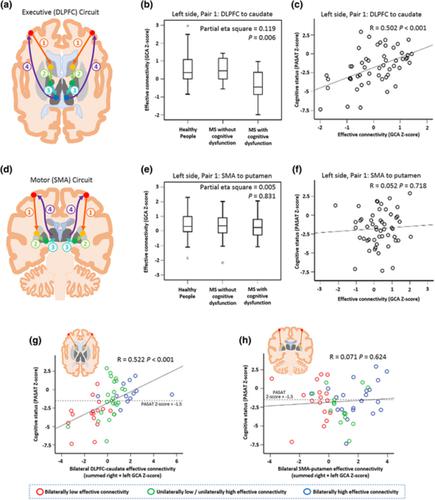当前位置:
X-MOL 学术
›
Hum. Brain Mapp.
›
论文详情
Our official English website, www.x-mol.net, welcomes your
feedback! (Note: you will need to create a separate account there.)
Dorsolateral prefrontal circuit effective connectivity mediates the relationship between white matter structure and PASAT‐3 performance in multiple sclerosis
Human Brain Mapping ( IF 3.5 ) Pub Date : 2020-10-19 , DOI: 10.1002/hbm.25239 Dewen Meng 1, 2, 3 , Thomas Welton 1, 4 , Afaf Elsarraj 1 , Paul S Morgan 2, 3, 5 , Roshan das Nair 6, 7 , Cris S Constantinescu 8 , Nikos Evangelou 8 , Dorothee P Auer 1, 2, 3 , Rob A Dineen 1, 2, 3
Human Brain Mapping ( IF 3.5 ) Pub Date : 2020-10-19 , DOI: 10.1002/hbm.25239 Dewen Meng 1, 2, 3 , Thomas Welton 1, 4 , Afaf Elsarraj 1 , Paul S Morgan 2, 3, 5 , Roshan das Nair 6, 7 , Cris S Constantinescu 8 , Nikos Evangelou 8 , Dorothee P Auer 1, 2, 3 , Rob A Dineen 1, 2, 3
Affiliation

|
Three decades ago a series of parallel circuits were described involving the frontal cortex and deep grey matter structures, with putative roles in control of motor and oculomotor function, cognition, behaviour and emotion. The circuit comprising the dorsolateral prefrontal cortex, caudate, globus pallidus and thalamus has a putative role in regulating executive functions. The aim of this study is to investigate effective connectivity (EC) of the dorsolateral‐prefrontal circuit and its association with PASAT‐3 performance in people with multiple sclerosis(MS). We use Granger causality analysis of resting‐state functional MRI from 52 people with MS and 36 healthy people to infer that reduced EC in the afferent limb of the dorsolateral prefrontal circuit occurs in the people with MS with cognitive dysfunction (left: p = .006; right: p = .029), with bilateral EC reductions in this circuit resulting in more severe cognitive dysfunction than unilateral reductions alone (p = .002). We show that reduced EC in the afferent limb of the dorsolateral prefrontal circuit mediates the relationship between cognitive performance and macrostrucutral and microstructural alterations of white matter tracts in components of the circuit. Specificity is shown by the absence of any relationship between cognition and EC in the analogous and anatomically proximal motor circuit. We demonstrate good stability of the EC measures in people with MS over an interval averaging 8‐months. Key positive and negative results are replicated in an independent cohort of people with MS. Our findings identify the dorsolateral prefrontal circuit as a potential target for therapeutic strategies aimed at improving cognition in people with MS.
中文翻译:

背外侧前额叶回路有效连接介导多发性硬化症中白质结构与 PASAT-3 性能之间的关系
三十年前,人们描述了一系列涉及额叶皮层和深层灰质结构的并行电路,这些电路在控制运动和动眼功能、认知、行为和情感方面发挥着假定的作用。由背外侧前额叶皮层、尾状核、苍白球和丘脑组成的回路在调节执行功能中具有假定的作用。本研究的目的是调查多发性硬化症 (MS) 患者背外侧-前额叶回路的有效连接 (EC) 及其与 PASAT-3 表现的关联。我们对 52 名多发性硬化症患者和 36 名健康人的静息态功能 MRI 进行格兰杰因果分析,推断患有认知功能障碍的多发性硬化症患者背外侧前额叶环路传入肢的 EC 降低(左: p = .006) ;右: p = .029),与单独单侧减少相比,该回路中的双侧 EC 减少会导致更严重的认知功能障碍( p = .002)。我们发现,背外侧前额叶环路传入肢中 EC 的减少介导了认知表现与环路组件中白质束的宏观结构和微观结构改变之间的关系。特异性表现为在类似的和解剖学上的近端运动回路中认知和 EC 之间不存在任何关系。我们证明了 MS 患者的 EC 测量在平均 8 个月的时间间隔内具有良好的稳定性。关键的阳性和阴性结果在独立的多发性硬化症患者队列中得到重复。我们的研究结果表明,背外侧前额叶环路是旨在改善多发性硬化症患者认知的治疗策略的潜在目标。
更新日期:2020-10-19
中文翻译:

背外侧前额叶回路有效连接介导多发性硬化症中白质结构与 PASAT-3 性能之间的关系
三十年前,人们描述了一系列涉及额叶皮层和深层灰质结构的并行电路,这些电路在控制运动和动眼功能、认知、行为和情感方面发挥着假定的作用。由背外侧前额叶皮层、尾状核、苍白球和丘脑组成的回路在调节执行功能中具有假定的作用。本研究的目的是调查多发性硬化症 (MS) 患者背外侧-前额叶回路的有效连接 (EC) 及其与 PASAT-3 表现的关联。我们对 52 名多发性硬化症患者和 36 名健康人的静息态功能 MRI 进行格兰杰因果分析,推断患有认知功能障碍的多发性硬化症患者背外侧前额叶环路传入肢的 EC 降低(左: p = .006) ;右: p = .029),与单独单侧减少相比,该回路中的双侧 EC 减少会导致更严重的认知功能障碍( p = .002)。我们发现,背外侧前额叶环路传入肢中 EC 的减少介导了认知表现与环路组件中白质束的宏观结构和微观结构改变之间的关系。特异性表现为在类似的和解剖学上的近端运动回路中认知和 EC 之间不存在任何关系。我们证明了 MS 患者的 EC 测量在平均 8 个月的时间间隔内具有良好的稳定性。关键的阳性和阴性结果在独立的多发性硬化症患者队列中得到重复。我们的研究结果表明,背外侧前额叶环路是旨在改善多发性硬化症患者认知的治疗策略的潜在目标。











































 京公网安备 11010802027423号
京公网安备 11010802027423号